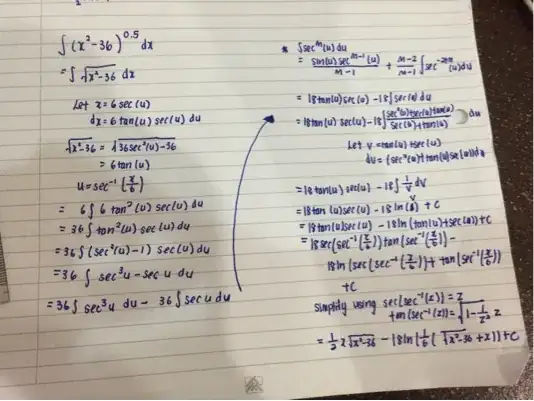Is there any simple method to solve this integral
$$\int \sqrt{x^2-36} \,dx$$
Because my method is a bit complicated and long: 
Is there any simple method to solve this integral
$$\int \sqrt{x^2-36} \,dx$$
Because my method is a bit complicated and long: 
If one restricts to using trigonometric substitution, this is roughly as clean as one can expect: Like you observe the integral $\int \sec u \tan^2 u \,du$ is more or less the same difficulty as evaluation $\int \sec^3 u \,du$ (the integrands differ by $\sec u$, which is standard); this calculation is tricky enough to warrant its own Wikipedia page.
There are at least two other techniques available.
Hyperbolic substitution Like OP pointed out in the comments, it's possible to evaluate the integral with a hyperbolic substitution. The identity $\cosh^2 u = \sinh^2 u + 1$ suggests the substitution $$x = 6 \cosh u, \qquad dx = 6 \sinh u \,du,$$ which transforms the integral to the simple-looking $$\int \sinh^2 u \,du.$$ In close analogy with the corresponding trigonometric integral, we can evaluate this in turn using the ''double-angle identity'' $$\cosh 2u = 2 \sinh^2 u + 1,$$ giving $$\int \sinh^2 u \, du = \frac{1}{2} \int (\cosh 2u - 1) \,du = \frac{1}{4} \sinh 2u - \frac{u}{2} + C.$$ With this technique the more demanding aspects of this integration are shunted into computing the antiderivative in terms of the original variable $x$; the expressions involving logarithms and radicals arise from the explicit formulas for the applicable inverse hyperbolic function.
The Euler Substitution Finally, we can use the so-called Euler Substitution, which transforms certain integrands involving a square root of a quadratic expression into a rational integrand. In this case, the appropriate substitution is $$\sqrt{x^2 - 36} = x + t.$$ Rearranging gives $$x = - \frac{t}{2} - \frac{18}{t} \, \qquad dx = \left(-\frac{1}{2} + \frac{18}{t^2}\right) dt,$$ so $$\sqrt{x^2 - 36} = x + t = \frac{t}{2} - \frac{18}{t}$$ and hence $$\int \sqrt{x^2 - 36} \,dx = \int \left(\frac{t}{2} - \frac{18}{t}\right) \left(-\frac{1}{2} + \frac{18}{t^2}\right) dt .$$ But this integrand in $t$ is rational; in fact, after distributing it is a sum of power functions and hence particularly easy to integrate. Reversing the substitution to write the antiderivative is $x$ is somewhat tedious but routine.
Make the change of variable $x=6\cosh u$. Then
$$\int \sqrt{x^2-36} \,dx=36\int \sinh^2u\,du=18\int(\cosh 2u-1)\,du=9\sinh2u-18u+C\\=\frac x2\sqrt{x^2-36}-18\text{ arcosh }\frac x6+C.$$
I think integration by parts is the shortest way here. Let $u = \sqrt{x^2 - 36}$ and $\mathrm dv = \mathrm dx$. Then, $$\begin{align} \int\sqrt{x^2 - 36}\,\mathrm dx &= x\sqrt{x^2 - 36} - \int\frac{x^2}{\sqrt{x^2 - 36}}\,\mathrm dx =\\[0.3em] &= x\sqrt{x^2 - 36} - \int\frac{x^2 - 36 + 36}{\sqrt{x^2 - 36}}\,\mathrm dx =\\[0.3em] &= x\sqrt{x^2 - 36} - \color{green}{\int\sqrt{x^2 - 36}\,\mathrm dx} - 36\int\frac1{\sqrt{x^2 - 36}}\,\mathrm dx=\\[0.3em] &= \frac x2\sqrt{x^2 - 36} - 18\int\frac1{\sqrt{x^2 - 36}}\,\mathrm dx =\tag{$\star$}\\[0.5em] &= \frac x2\sqrt{x^2 - 36} - 18\operatorname{arccosh}\frac x6 + C' \end{align}$$
In step $(\star)$ we moved the highlighted term to the LHS and divided by $2$. Then we used the fact that $$\frac{\mathrm d}{\mathrm dx}\operatorname{arccosh} x = \frac1{\sqrt{x^2 - 1}}.$$
You can also rewrite the result in another form, using $\operatorname{arccosh} x$ definition: $$\operatorname{arccosh} x = \ln\left(x + \sqrt{x^2 - 1}\right);$$ in this case, we can write $$\begin{align} \int\sqrt{x^2 - 36}\,\mathrm dx &= \frac x2\sqrt{x^2 - 36} - 18\ln\left(\frac x6 + \frac16\sqrt{x^2 - 36}\right) + C' =\\[0.3em] &= \boxed{\displaystyle\frac x2\sqrt{x^2 - 36} - 18\ln\left(x + \sqrt{x^2 - 36}\right) + C} \end{align}$$
If we put $x = \sqrt{t^2+36}$, then $dx = \frac{2t}{\sqrt{t^2+36}}\,dt$ and $$\int\sqrt{x^2-36}\,dx= \int \frac{2t^2}{\sqrt{t^2+36}}\,dt$$ which leads back to Difficult Integral: $\int\frac{x^n}{\sqrt{1+x^2}}dx$